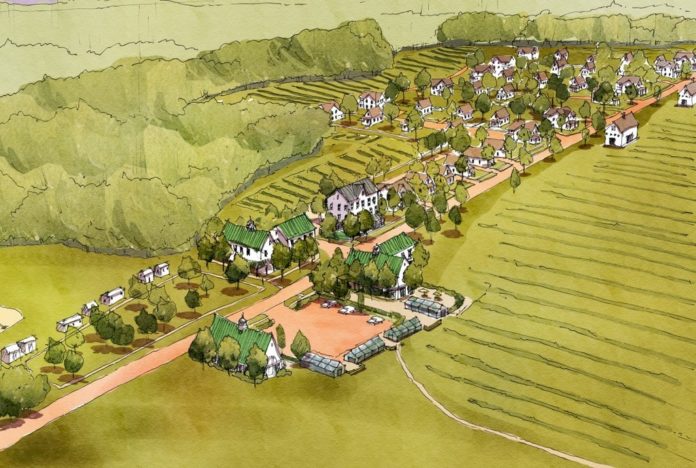
The design for the $14 million mixed-use artist community on the 200-acre Sandywood Farm has garnered a 2007 Charter Award from the Congress for the New Urbanism New England.
The farm, at 580 Cornell Road in Tiverton, has an application pending for affordable-housing state tax credits that would be awarded next January.
“We’ve done a lot of engineering work, a lot of design work and the preliminary designs have been approved by town officials,” said Stephen Ostiguy, executive director of Newport-based nonprofit Church Community Housing Corporation, which has an option to buy the farm. “We are well along,” he said. “The big thing to make it happen is the state approving tax credits.”
Joe Bossom, owner and operator of the farm, had the initial idea for the artist and agrarian community. He sought out CCH, which then hired Donald Powers Architects to develop the award-winning design.
The design is for studio and retail space, along with 50 affordable cottages for artists and 21 market-priced houses. The development is to be clustered to ensure it has minimal impact on the working farm.
This year, CNU-NE drew about 20 submissions for the Charter Awards, said Douglas Storrs of Cornish Associates, a member of the 2007 Charter Awards jury.
“The number of submittals has been going up each year – which is great – as the Congress for New Urbanism New England Chapter comes into its own,” said Storrs, who was an inaugural member of the national CNU, founded in 1993.
The Tiverton project was chosen as a model of rural new urbanism for several design elements, said Storrs. Along with the architecture of the buildings and sustainable energy, the design also encourages the farm to continue operations, which was one of Bossom’s stipulations for the project.
In their submission, Donald Powers Architects stressed their adherence to the charter principles, including a strong relationship between farmland and living space and a broad range of housing prices intended to attract “diverse ages, races and incomes into daily interaction.”
Dana Powers, vice president and director of marketing for Donald Powers Architects, said the project is a rural translation of the concepts that many of the firm’s urban designs incorporate. It uses the small-scale walkability that the firm strives for in urban design, but is unique in its rural location and attempt to preserve the farm, she said.
The architecture draws from rural Tiverton and Little Compton’s historic designs, but adds modern building techniques, said Powers. The design incorporates structural insulated panes, cellulose insulation and windows and overhangs that will help heat and cool the interiors.
“I think we’re always interested in pushing the element of sustainable energy and design, so we’re already pushing some of these techniques into our other projects,” said Powers.
The design also incorporates a wind turbine that would bring green energy to the affordable housing units. The wind speed around the site, one of the highest altitudes in Tiverton, is currently being tested with a meteorological tower, Ostiguy said.
Preliminary results show an average wind speed of about 11 mph, which could produce about 250 kilowatts, enough electricity for the project, he said.
“You need to go through a year-long testing period to see if a site is, basically, windy enough. So we’re about a quarter of the way through the testing,” said Powers.
Although other facets – including those for sustainable energy and design – of the Tiverton project will likely influence the firm’s future urban designs, the wind turbines are less likely to be found away from rural areas.
“This is the first one we’ve done. It depends on the site and the project. It wouldn’t be as easy to do in the Smith Hill neighborhood of Providence, but it works in Tiverton,” said Powers.












